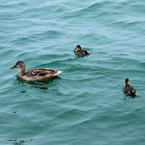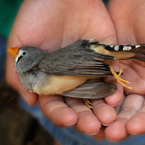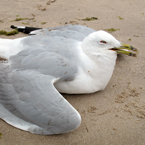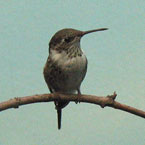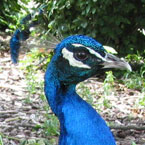Seagull
Gulls (often informally called seagulls)
are birds in the family Laridae. They are most closely
related to the terns (family Sternidae) and only
distantly related to auks, skimmers, and more distantly
to the waders. Until the twenty-first century most
gulls were placed in the genus Larus, but this arrangement
is now known to be polyphyletic, leading to the
resurrection of several genera.
Gulls are typically medium to large birds, usually
grey or white, often with black markings on the
head or wings. They typically have harsh wailing
or squawking calls, stout, longish bills, and webbed
feet. Most gulls, particularly Larus species, are
ground-nesting carnivores, which will take live
food or scavenge opportunistically. Live food often
includes crabs and small fish. Gulls have prophylactic
unhinging jaws which allow them to consume large
prey. Apart from the kittiwakes, gulls are typically
coastal or inland species, rarely venturing far
out to sea The large species take up to four years
to attain full adult plumage, but two years is typical
for small gulls. Large White-Headed Gulls are typically
long-lived birds, with a maximum age of 49 years
recorded for the Herring Gull.
Gulls nest in large, densely packed noisy colonies.
They lay two to three speckled eggs in nests composed
of vegetation. The young are precocial, being born
with dark mottled down, and mobile upon hatching.
Gulls—the larger species in particular—are
resourceful, inquisitive and intelligent birds,
demonstrating complex methods of communication and
a highly developed social structure. For example,
many gull colonies display mobbing behaviour, attacking
and harassing would-be predators and other intruders.
Certain species (e.g. the Herring Gull) have exhibited
tool use behaviour, using pieces of bread as bait
with which to catch goldfish, for example. Many
species of gull have learned to coexist successfully
with humans and have thrived in human habitats.
Others rely on kleptoparasitism to get their food.
Gulls have been observed preying on live whales,
landing on the whale as it surfaces to peck out
pieces of flesh.
(Source: Wikipedia.org)
|







